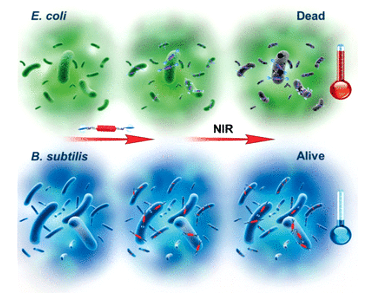Overcoming Antibiotica Resistance with Photothermal Treatments
A new photothermal treatment could help to overcome antibiotic resistance. In this method, an agent transforms near-infrared light into local heating, which kills the pathogens. However, this “transformer” must first be activated. In this case the target bacteria do this themselves. Other types of bacteria do not switch the agent on and remain unharmed.
The excessive and improper use of antibiotics has led to a sharp increase in highly dangerous, resistant bacteria. Photothermal treatments are an interesting new approach for overcoming resistance. They involve increasing the temperature locally through exposure to light, causing the proteins in the microbes to denature and killing them.
This requires substances that can efficiently transform the light into heat. Previous photothermal transformers bound non-specifically to the bacteria through electrostatic interactions. This does not allow for the selective inhibition of specific bacteria, which is desirable because the majority of the bacteria in our bodies are harmless or even necessary, like some gut bacteria.
Photothermal Agent Only Activated When Switched On by Bacteria
Scientists led by Jiang-Fei Xu and Xi Zhang at Tsinghua University and the Chinese Academy of Sciences, Beijing, have developed a photothermal agent that is only activated when it is “switched on” by the bacteria. Only certain bacteria, known as facultative anaerobic bacteria, can do this.
The new agent is a complex consisting of three molecules: a perylene diimide derivative as the rod-shaped center piece with both of its ends located inside the cavities of pumpkin-shaped macrocycles (cucurbituril). The “pumpkins” prevent the rods from non-specifically inserting into the membranes of bacteria and at the same time preventing the rods to aggregate into stacks.
Certain reagents can reduce perylene diimides to radical anions. Interestingly, facultative anaerobic bacteria like Escherichia coli can also do this. The reduction changes the optical properties of the complex: The radical anion can absorb near infrared light and releases the energy as heat. The area around the E.coli gets very warm, killing them off.
In contrast, aerobic bacteria like Bacillus subtilis do not overheat, because they do not switch on the transformer. The researchers believe that hydrogenases, enzymatic proton transporters are responsible for the reduction and thus the “switching”. These are only found in large numbers in the membranes of anaerobic and facultative anaerobic bacteria. It may be possible to use these concepts to develop treatments that regulate the balance of microbes, such as gut bacteria, as well.
- Supramolecular Radical Anions Triggered by Bacteria In Situ for Selective Photothermal Therapy,
Yuchong Yang, Ping He, Dr. Yunxia Wang, Dr. Haotian Bai, Shu Wang, Jiang-Fei Xu, Xi Zhang,
Angew. Chem. Int. Ed. 2017.
https://doi.org/10.1002/anie.201708971




